Lecture
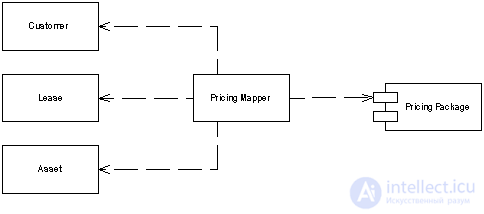
Mapper Design Pattern
An object that manages communication between objects that are independent of each other.
Sometimes it is necessary to establish a message between two subsystems, which, meanwhile, must remain in ignorance of each other. This may be due to the inability to change these objects, or simply unwillingness to create dependencies between them or between them and the insulating part.
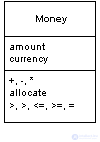
Money Design Pattern
A huge number of computers in the world process data about money. Surprisingly, the Money class is still not basic in any programming language. The lack of this type of data leads to problems, the most notable of which is working with currency. If all calculations in the program are done in one currency, there are no special problems, but as soon as multi-currency is introduced, you need to think about not folding $ 10 with 10 yen without translating currency rates. The problem with rounding is less noticeable. Cash calculations are often rounded to the smallest of existing measures. It is easy to ignore a penny due to rounding errors.
What is really good about OOP is that you can fix these problems by creating a Money class to work with monetary values and avoid common mistakes.
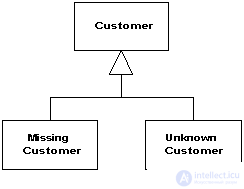
Special Case Design Pattern
A subclass containing special logic for individual situations.
Null-values in OOP is a clumsy thing, as it hacks polymorphism at the root. It is usually possible to call any method on a variable of a given type without having to worry about whether this variable belongs to a particular class or subclass. In strongly typed languages, this check is done by the compiler. However, due to the fact that the variable may contain null, there is a danger of an error occurring at run time when the method is called on a null value.
If a variable can be null, you need to constantly take care of checks for null and the proper handling of null values. Often, this "correct handling" is the same in most cases, and all this ends in the commission of sin by duplicating the code (literal translation by Martin Fowler).
Null-values are a vivid example of such problems that arise constantly and suddenly. And a lot of them. For example, in many systems one has to work with infinity, which has special rules for, for example, addition and violates ordinary axioms that are valid for natural numbers. Such cases imply a change in the usual type behavior.
Instead of returning null or some additional value, return Special Case (Special Case) - an object with the same interface, but behaving differently than the main one.

Pattern Design Plugin
Connect classes during configuration, not compilation.
The Separated Interface pattern is often used when one code is executed in several environments and requires different implementations of separate logic. Most developers do this by using a factory pattern. Imagine that you need to generate a primary key using the Separated Interface pattern. For unit testing, you can use a simple counter object, and on a real system - a sequence from the database. The factory method is likely to contain a conditional transition (if), checking if the test flag is set, and return the necessary key generator.
As soon as you have a few more factories, confusion will begin. Creating a new configuration, for example, “launching unit tests on a database without transaction control” or “launching in production on DB2 with full transaction support”, will require changes in conditions in a large number of factories, reassembly and redevelopment.
The configuration should not be scattered across the application, as well as require rebuilding and redeployment. The Plugin pattern solves both of these problems by providing a centralized, dynamic configuration.

Gateway Design Pattern
An object that encapsulates access to an external system and resource.
Decent software rarely functions in isolation from the outside world. Even the most strictly object-oriented system often has to interact with non-objects, such as a relational database, CICS transactions, or XML structures.
When accessing such external resources, the API is usually used. However, APIs are initially somewhat complex, because they take into account the structure of the resource. Anyone who wants to understand a resource must understand its API - be it JDBC or SQL for relational databases or W3C or JDOM for XML. This makes the software not only less understandable, but it also makes the changes much more complicated, for example, if you are going to switch from SQL to XML over time.
The solution here is to wrap the entire special API into a class whose interface looks like the interface of a regular object. The remaining objects access the resource through this Gateway, which translates these simple calls to the appropriate special API code.
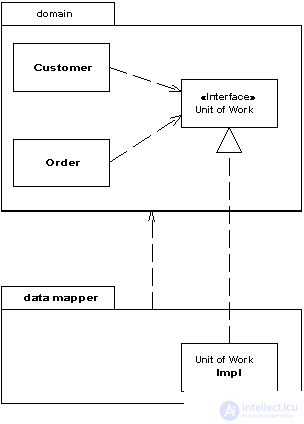
Design Pattern Separated Interface
Selecting an interface to an object in a separate package from the object.
When developing any system, it is possible to achieve improvement of its architecture, reducing connectivity between its parts. This can be done so - by distributing the classes into individual packages and control dependencies by these packages. Then you can follow the rules about how classes from one package can access classes from another package. For example, one that prohibits classes from the data layer from accessing classes from the presentation layer.
However, it may be necessary to implement methods that conflict with the underlying dependency structure. In this case, you can use a dedicated interface to define an interface in one package and implement it in another. Thus, any client that needs a dependency on this interface may not think at all about the implementation of access. The Separated Interface Pattern provides a good connection point for the Gateway pattern.

Registry Design Pattern
A well-known object that is used by other objects to obtain common objects and services.
When you need to find an object, you usually start with another object associated with the target. For example, if you need to find all accounts for a buyer, start with the buyer and use his method of receiving bills. However, in some cases there is no suitable object from which to start. For example, the buyer's ID is known, but there is no link to it. Then you need a kind of search engine object, but then the question arises - how do you find the search engine itself?
The registry (Registry) - is a global object in its essence, or at least it looks like this - it can function only when it is global.
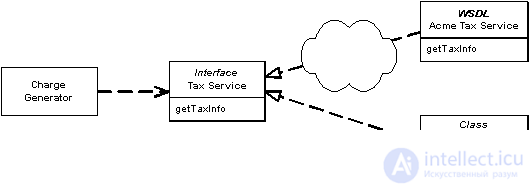
Service Stub Design Pattern
Eliminates dependence on external problem services during testing.
Enterprise systems often depend on external services, such as, for example, calculating credit ratings, tax rates, etc. Any developer who has ever dealt with such systems will complain about their extra dependence on an absolutely uncontrolled resource. Often these services do not shine with stability and reliability.
As a result, these problems can slow development. Developers are forced to sit and wait for the remote service to resume its work or embed “crutches” into the code in order to bypass the dependency on the service. Even worse, when it fails to perform tests - the whole development process is broken.
Replacing the service with a stub (Service Stub), which is performed locally and quickly, will improve development.
A small object for storing values such as money or a range of dates whose equality is not based on identity.
When working with OOP, you come to the conclusion that it is useful to separate reference objects and value objects. The object value is usually much smaller. It is a simple data type from those languages that are not fully object-oriented.
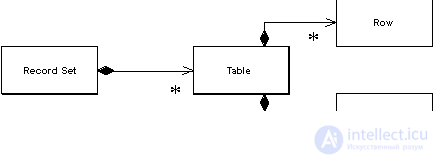
Record Set Design Pattern
Presentation of data from the table in the application.
Over the past twenty years, relational tables have become the main way of presenting data in a database. Almost every new developer uses relational data.
On this basis, a lot of tools appeared to quickly build a UI (user interface). These UI frameworks are based on data relationality and provide various UI elements that are easily customized and managed almost without any programming.
The flip side of the coin is that, despite the incredible ease of outputting and working with data, these elements do not provide for the possibility of adding a business logic code. Checks like "whether this date has the right format" and any rules of execution simply have nowhere to put. And as a result, this logic is either clogged in the database, or mixed in the information output code.
The essence of the Record Set is to provide a data structure that looks exactly like the result of a SQL query, but can be controlled and processed by any part of the system.
A type that acts as a parent for all types in its level.
Often, all classes of the same level have the same methods that do not want to duplicate everywhere. In order to avoid duplication, you can transfer all common methods into one class (Layer Supertype), which will be the Supertype (read - parent) of all classes in its level.

Singleton Design Pattern
In an application, an instance of a particular class must be present guaranteed in one instance.
In essence, a static instance of the class is created: protected from cloning, ordinary instantiation through the constructor, and other ways of obtaining a reference to a single instance — apart from the static constructor method.
PHP7 implementation example
| namespace DesingPatternsRu \ Example; | |
| / ** | |
| * | |
| * @author samizdam | |
| * / | |
| final class singleton | |
| { | |
| private static $ instance = null; | |
| public static function getInstance (): self | |
| { | |
| if (empty (self :: $ instance)) { | |
| self :: $ instance = new self (); | |
| } | |
| return self :: $ instance; | |
| } | |
| private function __conctorctor () | |
| { | |
| // Protection from direct creation | |
| } | |
| private function __clone () | |
| { | |
| // Protection against instance cloning | |
| } | |
| private function __sleep () | |
| { | |
| // Protection against attempting to serialize with subsequent retrieval | |
| } | |
| } |
view rawSingleton.php hosted with ❤ by GitHub
Singleton is often called an “anti-pattern” because when used, it carries the following problems:
These reasons reduce the testability of the code.
Since this is one of the easiest to understand patterns, it is often used by beginners, while abusing them. At the same time, for some tasks, when you need a global object, and the simplest way to access it from anywhere in the application (for example, Service Locator), the simplest solution is Singleton.
Comments
To leave a comment
Web site or software design
Terms: Web site or software design